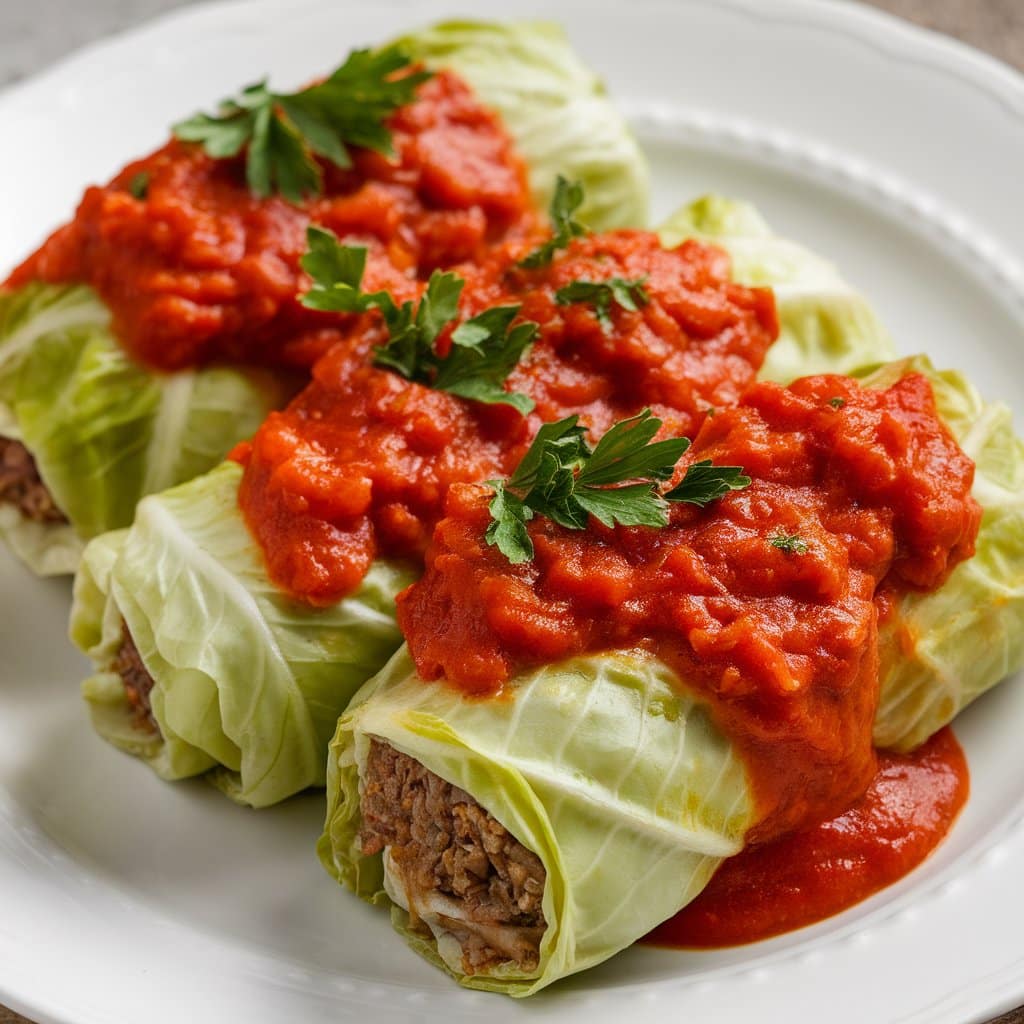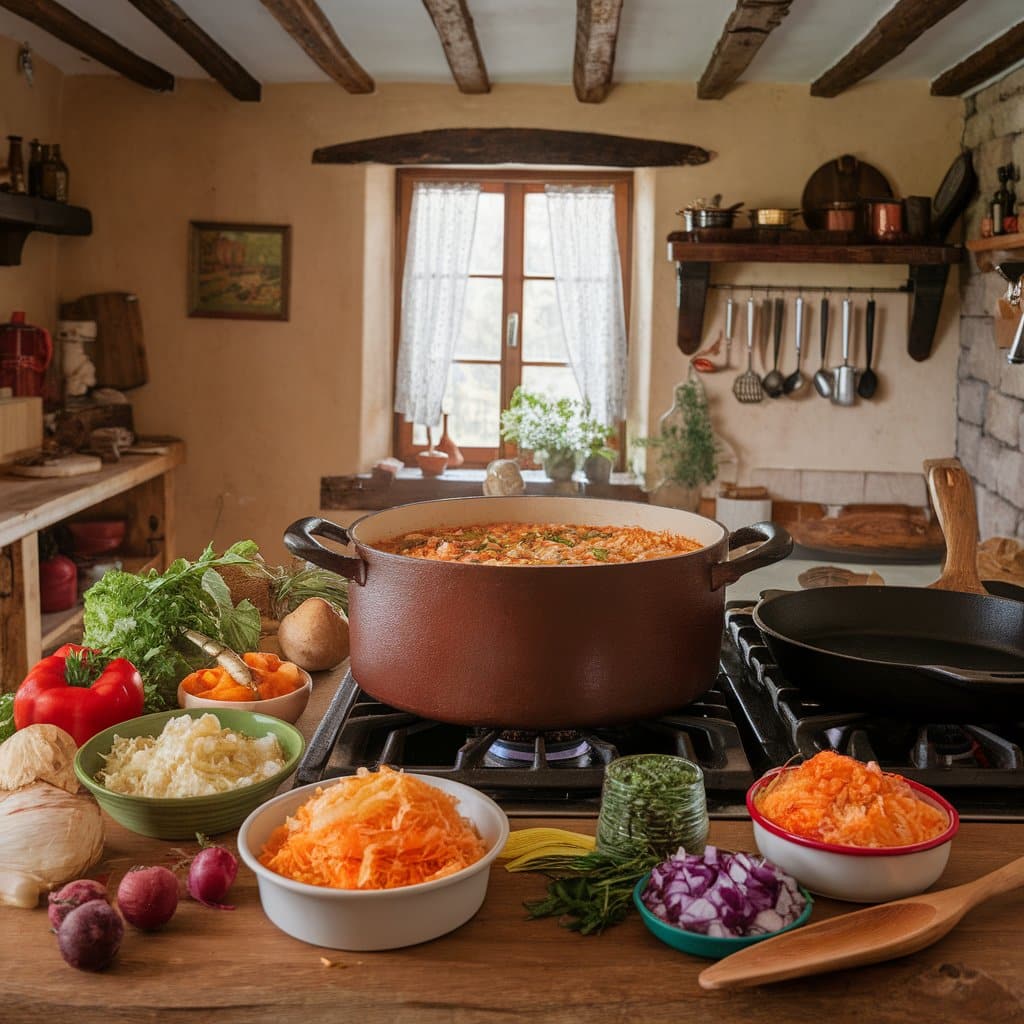Polish Comfort Classics
I recall the delightful smells from my grandma’s kitchen, where the wonders of Polish cooking came alive in a simmering pot of bigos and neatly shaped pierogi. These dishes were a comforting presence on a chilly night in Warsaw, a reassuring gesture that conveyed, “everything’s going to be okay.”
Fast forward to today, and my quest for that nostalgic comfort has turned into a full-blown love affair with Polish comfort classics. I proudly represent the rich and comforting flavors of my heritage, and I’m excited to share that passion with you.
Let’s discuss the delicious foods of Poland that can lift your spirits and make you feel warm inside. Picture a spoon going into a hot bowl of barszcz, the deep red beetroots hinting at a mix of sweet and sour flavors. That’s the type of experience I’m excited to share with you.
By the time we reach the crispy edges of a perfectly golden ‘placki ziemniaczane’, you’ll want to book your next flight to Gdansk. Before we start this journey together, I want to assure you that everything I share comes from my own experiences and a touch of Polish pride.
Get ready to enjoy the delicious flavors of Polish comfort food, where each bite has a story to tell and every story is worth enjoying.
Key Points That You Should Know
1. I’ve always found that Polish cuisine offers a deep sense of comfort and warmth, which may explain why dishes like pierogi and bigos have become beloved comfort classics. Each bite of these dishes seems to wrap you in tradition and history, showcasing the rich culinary heritage of Poland.
2. Through my exploration of these comfort foods, I’ve learned that pierogi are incredibly versatile, being filled with anything from savory minced meat, cheese, and potatoes, to sweet fruits for a dessert twist. This adaptability allows pierogi to be a staple in the Polish diet, reflecting the resourcefulness ingrained in Polish cooking.
3. Another dish that stands out to me is rosół, a clear chicken soup that is a traditional remedy for colds and a staple for Sunday dinners. Its nurturing flavors remind me of the universal power of a good broth, and in Poland, the care put into simmering the perfect rosół speaks volumes about the love infused in family meals.
4. I can’t talk about Polish comfort food without mentioning gołąbki, cabbage rolls filled with meat and rice or buckwheat, which are simmered in a rich tomato sauce. I appreciate how this dish, like many Polish classics, balances heartiness with simplicity. It showcases the country’s agricultural roots, with cabbage and grains forming a satisfying meal that’s deeply satisfying.
5. Finally, the hearty stew known as bigos, often referred to as Hunter’s Stew, is a winter staple that has impressed me with its robust flavors. It’s a dish that truly evolves as it’s made, typically with various meats, sauerkraut, fresh cabbage, and a mix of wild mushrooms, which merge over time to create an even more powerful taste. Bigos perfectly illustrates the Polish talent for creating depth of flavor using simple, local ingredients.

Finding Heartwarming Polish Comfort Food
I always find myself drawn to the enticing aroma of a Polish kitchen, where the promise of hearty stews and rich, dough-based treats await. Whenever I venture into the world of Polish comfort foods, the sheer variety available excites me greatly. Dishes like Pierogi, those delicate dumplings stuffed with an array of fillings, make me feel instantly at home.
Embracing the Complexity of Bigos
My culinary adventures would be incomplete without mentioning Bigos, a hunter’s stew that defines the term ‘slow-cooked’. This Polish classic, with its complex flavors melding together sauerkraut, fresh cabbage, various meats, and a blend of spices, is a testament to the depth of Polish cuisine. Each bite tastes like a piece of history, and I relish the simmering process that could take hours, or even days, to perfect.
Experiencing the Joy of Baking Polish Breads
There’s something inherently satisfying about baking bread from scratch, and Polish breads, like Chleb rye bread, are no exception. The crusty exterior and dense, flavorful interior make it an ideal comfort food, especially when slathered with a layer of creamy smalec or topped with a slice of traditional smoked kielbasa.
The pleasure of watching the dough rise, the aroma of bread in the oven—these are the simple joys of Polish comfort baking.
Rediscovering the Simplicity of Placki Ziemniaczane
In my kitchen, quick and savory delights hold a special place, and Placki Ziemniaczane encapsulates this perfectly. These Polish potato pancakes, crisp and golden-brown, serve as a humble reminder of how simple ingredients can transform into something exceptionally comforting. I see them as a canvas for a variety of toppings, garnished often with sour cream or a sprinkle of sugar.
The Social Aspect of Sharing a Meal
Sharing these meals with friends and family amplifies the comfort they provide. I think of how a communal setting enhances the enjoyment of Żurek, a sour rye soup commonly served in a bread bowl. There’s an intimacy to breaking bread together, metaphorically and physically, dipping chunks of fresh bread into the tangy broth, and savoring the shared experience.
How Do I Pair Beverages with Polish Comfort Foods?
- To complement the robust flavors of a hearty Bigos, I recommend a full-bodied red wine or a dark Polish beer to cut through the richness.
- When enjoying Pierogi, a chilled glass of white wine or a light pilsner can balance the dish’s heartiness.
- For the sweetness of Pączki, those irresistible Polish doughnuts, a cup of strong black coffee is my beverage of choice.
- Lastly, soups like Barszcz can be paired beautifully with a rye vodka, heightening the beet soup’s earthy tones.
Final Thoughts on Polish Comfort Classics
As someone who loves exploring the depths of various cuisines, I find Polish Comfort Classics to be a treasure trove of wholesome and satiating dishes. The act of preparing these meals feels like an invitation into a Polish family home, offering warmth and tradition in every spoonful.
From the doughy delights of Pierogi to the deep, rich flavors of a stew like Bigos, there’s a charm to Polish cooking that’s hard to replicate elsewhere.
The essence of these dishes goes beyond their ingredients; it’s the love and care that’s traditionally put into preparing them, bringing families and friends together, generation after generation.
The ability to recreate these comforting recipes at home, perhaps even adding a personal healthy twist or an infusion of modern culinary techniques, is a testament to the adaptability and enduring appeal of Polish cuisine. And who knows? Maybe a plate of delicious Pierogi or a bowl of steaming Żurek will become part of your own comfort food repertoire.
FAQ
What are Polish Comfort Classics?
Polish Comfort Classics refer to traditional Polish dishes that typically offer a warm, hearty, and homey feeling. These meals are often associated with nurturing and the kind of food you’d expect on a family dinner table in Poland. Dishes like Pierogi, Bigos (Hunter’s Stew), and Żurek (Sour Rye Soup) are cornerstone recipes of Polish comfort food.
Why is Pierogi considered a comfort food?
Due to its tender dough filled with a variety of satisfying fillings like potato and cheese, meat, or fruits, Pierogi is the quintessential comfort food. It is both filling and delicious, evoking a sense of warmth and homeliness with each bite. Pierogi is a dish that’s commonly shared among family and friends, enhancing its comforting allure.
Can Polish Comfort Classics be made vegetarian?
Absolutely! Many Polish dishes can be adapted to a vegetarian diet. For instance, the classic Pierogi can be stuffed with mushrooms and cabbage instead of meat. Dishes like Placki Ziemniaczane (Potato Pancakes) are inherently vegetarian and are incredibly satisfying.
Are there any quick versions of Polish Comfort Classics?
Yes, quicker versions exist for those short on time. For example, you can use store-bought dumpling wrappers instead of homemade dough for Pierogi or opt for pre-cut vegetables when making a dish like Bigos. Quick-cooking versions may not be entirely traditional, but they certainly deliver on flavor and comfort!
What are some must-try sweets in Polish cuisine?
Polish cuisine offers a delightful array of sweets; Sernik (Polish cheesecake) and Makowiec (Poppy Seed Roll) are particularly must-try desserts. These treats provide a perfect balance of sweetness and texture, terrific for concluding a comfort meal on a high note.
Is Polish Comfort Food healthy?
While Polish Comfort Classics are hearty and sometimes indulgent, they can be tailored to be healthier. Using leaner cuts of meat, incorporating more vegetables, or reducing cream in soups are some ways to enjoy these dishes with a healthier twist.
What should I serve with my Polish Comfort Classics?
Polish meals are often accompanied by simple sides that complement the main dish. A side of Kapusta (braised cabbage) or a fresh cucumber salad are excellent choices. Rye bread is commonly served alongside soups and stews to round out the meal.
How do I store leftovers from Polish Comfort Classics?
Leftovers can generally be refrigerated in an airtight container for a few days. Many Polish dishes, like soups and stews, taste even better the next day as the flavors have more time to meld together. Make sure to reheat thoroughly before serving!
Are these recipes difficult to make?
Some Polish Comfort Classics can be intricate, but there’s always a level of simplicity in these recipes making them approachable for home cooks. With patience and following step-by-step instructions, even novice chefs can recreate these delicious dishes.
Can I use modern kitchen gadgets to make Polish Comfort Classics?
Definitely! Modern kitchen appliances can simplify the cooking process. For instance, a slow cooker is great for Bigos, while a food processor can streamline dough preparation for Pierogi. Embracing modern conveniences can coexist with making traditional food.
Related Posts
About The Author
John Watson
John Watson is the passionate food enthusiast behind MePlusFood.com. With a deep love for exploring culinary delights, he shares honest restaurant reviews, mouthwatering recipes, and culinary adventures. Join John on his flavorful journey to savor the world one bite at a time.
